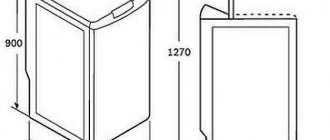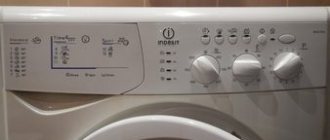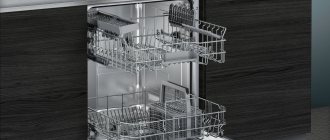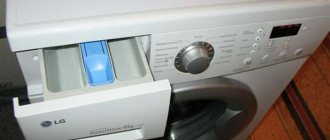The size of kitchens and bathrooms in many homes often leaves one wanting more. Therefore, you should buy large-sized equipment after choosing a place for it in advance. Knowing the sizes of washing machines will help in this difficult task. Only by carefully studying the standard and non-standard dimensions of the equipment can you be sure that the chosen option will fit perfectly into the prepared niche or opening.
The dimensions of automatic washing machines largely depend on the type of load and the volume of the drum. When these indicators change, the depth of the device usually changes. The width and standard height of the washing machine most often remain unchanged. However, some manufacturers produce models that differ radically in their dimensions, which we will consider a little later.
Load Type
According to the method of loading laundry, all washing machines are divided into 2 types:
- Front loading. In these models, a transparent loading hatch is located on the front panel.
- Top loading. In such washing machines, the laundry is loaded from above, through the drum hatch.
Front-loading models, in turn, can be:
- Narrow.
- Standard.
- Full size.
Let's take a closer look at the dimensions of each type of washing machine.
How to choose?
Modern washing machines, which feature vertical loading of laundry, are sold in many stores. They are produced by large brands, famous for the highest quality of their products. With a large assortment of branded devices, the average buyer can simply get confused.
Let’s consider, “looking” at what criteria, you should select a vertical machine of suitable dimensions.
- Dimensions. Find free space for future installation of your planned purchase. Once you find it, you will need to take all the necessary measurements to find out what size equipment will fit here and will not interfere. Once you know all the required sizes and areas, you can go to the store.
- Parameters and configurations. Vertical machines are often equipped with a large number of useful options and functions. Decide in advance for yourself which of them you will really need and useful, and which there is no point in overpaying for. Consider the energy consumption parameters and washing class of the equipment, as well as its capacity. If you buy a device for 2 people, then you can choose a small-sized device with a modest capacity. If the purchase is made for a family of 3–4 or more people, then you will need a model with a loading capacity of 6–7 kg.
- Build quality. Carefully inspect the washing machine you choose. All connections in the structure must be strong and reliable. There should be no cracks or loose parts under any circumstances - this applies to all elements of equipment. Inspect the body: there should be no scratches, dents, chips or traces of rust. If you find similar defects in household appliances, it is better to refuse the purchase.
- Manufacturer. It is recommended to buy exclusively branded household appliances of the type considered. Fortunately, today many companies produce vertical units, so the consumer has plenty to choose from. Branded devices are good not only for their impeccable quality, but also for their warranty from the manufacturer.
A model of ideal sizes should only be purchased at a specialized household appliances store. Here you can buy original branded equipment.
Sales consultants will help you find the ideal machine according to the required dimensions.
You should not buy such equipment from dubious retail outlets, even if they sell it at a lower and more attractive price. Many buyers who want to save money buy cars in such places, which they later regret.
If a washing machine bought here breaks down or you find a defect in it, you are unlikely to want to replace or repair it. You will have to repair the equipment yourself, and in the case of vertical options, this can be very expensive.
Dimensions of top-loading washing machines
The sizes of such units do not differ in variety. All top loading washing machines have standard sizes:
- Depth 60 cm.
- Width 40 cm.
- Height 85 cm.
There may be slight measurement error due to protruding parts. For example, the Indesit ITW D 51052 W washing machine is 90 cm high due to the raised control panel.
Indesit ITW D 51052 W 1
conclusions
When making a choice in favor of a particular brand of automatic washing machine, it is recommended in advance:
- accurately measure the maximum height, width and depth of the place where the equipment will be installed with a margin of 1 cm;
- take into account the size of doorways for transporting the unit;
- provide a space of at least 5-6 cm to the rear wall for connecting hoses to drain pipes.
When purchasing built-in household appliances, you must also take into account its height.
Subscribe to TechnoCouncil on social networks so you don’t miss anything:
Depth of narrow washing machines
Models up to 40 cm wide are considered narrow. As a rule, the maximum possible load for them is 3.5–4 kg. Sometimes manufacturers use a trick - they stretch the diameter of the drum, leaving its depth unchanged, in order to increase the volume of laundry to 4.5–5 kg.
An example of a narrow model with a small load is the Candy CS34 1051D1/2. Its depth is only 34 cm, while the tank can fit up to 5 kg of dry laundry.
Candy CS34 1051D1/2 1
Such models have a number of significant disadvantages:
- A narrow drum prevents full circulation of the washing solution, so the quality of washing with a full load may be lower.
- Low stability and strong vibration during spinning.
- High noise level.
- Severe wear of parts and shorter service life due to strong vibration.
The undeniable advantage of these models over standard ones is their shallow depth, which allows you to significantly save space in the bathroom.
Dimensions of built-in equipment
Appliances that can be installed in the kitchen are very popular. Such models can be mounted in a cabinet or under a tabletop, which allows you to increase the usable space in the room. To ensure that the “washing machine” fits harmoniously into the overall style of the kitchen, a decorative door is hung on it.
The standard height of built-in models is 850 mm. The width also has classic dimensions - 595–600 mm.
The most varied is the depth parameter, although deep and narrow models cannot be found on sale. Wide ones simply won’t fit in the headset, while narrow ones leave a lot of free space. Therefore, the most optimal depth is from 560 to 580 mm.
Depth of standard washing machines
The depth of a standard washing machine is 40–45 cm. The load depends on the size of the drum and can be 4-7 kg. Such a machine will include not only personal, but also large-sized items, such as winter clothes or a couple of sets of bed linen. These models are the most popular among buyers. They don't take up much space and allow you to wash a large amount of clothes at one time.
There are quite a lot of standard options sold, for example, Bosch WLN 24242. This free-standing model has a depth of only 45 cm. But it is designed for 7 kg of dry laundry. This means that large items such as a double blanket or a winter jacket can fit in it.
Bosch WLN 24242 1
Depth of full-size models
Their depth starts from 45 cm and reaches 60. Such units are not in great demand due to limited space in apartments. However, they have a number of undeniable advantages:
- Large load up to 10 kg, depending on the design features of certain manufacturers' products.
- Spin stability.
- Things of any size can be rinsed and washed well, thanks to the free circulation of water and washing solution through the thickness of the fabric.
Full-size options are quite common; an example is the Asko W6444 ALE model with a depth of 59 cm.
Asko W6444 ALE 1
Washing machine width
The standard width of a washing machine is 60 cm, regardless of its depth. It is the same for both narrow and full-size models. The only exceptions are semi-automatic, compact and vertical machines.
There can be many examples of equipment of this width, both among budget manufacturers and among premium companies, for example, Bosch WLK 20266
Bosch WLK 20266 1
Washing machine height
The height of a standard washing machine is 85 cm. Some buyers wonder why exactly these numbers are taken when developing equipment. Why, for example, not 80 or 90 cm?
The thing is that 85 cm is the standard height of the countertop set, calculated for ergonomic reasons for a person 170 cm tall. It is with this arrangement of hands and body that the load during cooking will be the least.
Accordingly, a washing machine with a height of 85 cm will stand flush with the countertop and will not protrude beyond it, creating additional discomfort.
Of course, if the washing machine is installed in the bathroom, you don’t need to attach such importance to the height. However, having opted for the top-loading option, you need to make sure that the lid can be safely opened and it will not touch any pipes or shelves.
An example of a washing machine of this height is the Hotpoint-Ariston ARSL 103.
Hotpoint-Ariston ARSL 103 1
What parameters are taken into account when choosing
To begin, choose a convenient installation method: washing machines can be built-in or free-standing. Then take measurements of the space in which the machine will be installed. Subtract 2 cm from the measured parameters: width, depth and height - this margin is necessary to compensate for vibrations during washing if you choose a built-in model. Based on these parameters, you will determine the dimensions of the washing machine.
Next, determine the degree of automation of your future machine: automatic or semi-automatic. Thanks to the rapid development of technology, polyautomatic machines, although they are losing their popularity, still remain relevant for some users.
After this, study the characteristics of the future assistant: the number of drum revolutions, the level of noise insulation, loading volume and additional functions.
Also, when choosing a washing device, pay attention to the location of the communications - from the wall to the machine, leave a gap of 4-6 cm for the hoses. Also pay attention to the width of the doorways through which the device will be carried - models with dimensions larger than 60 cm will not fit in the doorway when assembled.
Since the standard dimensions of a washing machine are 85-90 cm in height, 60 cm in width and 50-60 cm in depth, it is quite difficult to place such large equipment in a small apartment o. Based on the needs for compact equipment, manufacturers began to offer small sizes of washing machines.
Dimensions of built-in washing machines
With the growing prosperity of the population, there is a trend towards the acquisition of built-in equipment. Washing machines and other household appliances are installed inside kitchen cabinets and covered with decorative panels, becoming one with the furniture.
The dimensions of built-in washing machines are slightly different from the dimensions of solo models. Narrow units for built-in installations are not produced. The standard depth of the headset is 60 cm, so there is no point in installing a machine at 35 cm. Its stability will be worse, the load will be less, and there will still be another 20–30 cm of unrealized free space behind the rear panel.
It is also quite problematic to install a full-size model with a depth of 60 cm into the set, since hoses must be placed behind the rear panel, and the facade will be attached to the front panel. Typically, a built-in washing machine is 50–55 cm deep.
An example is MAUNFELD MBWM.1485W, which has dimensions of 60x55x82
MAUNFELD MBWM.1485W 1
Some free-standing models can also be built into the headset. Just unscrew the top cover. The machine will become lower by a couple of centimeters - this is enough for it to fit under the countertop. Of course, you can’t hang the facade on it; the hatch and control panel will remain visible.
Please note that not all solo machines can be installed this way. For example, in the Hotpoint-Ariston AQ105D 49D B model, the hatch is flush with the side walls and even if you remove the cover from above, it will protrude. The overall height of the unit will not decrease.
Tips and tricks for installation and placement
First of all, the unit is freed from transportation accessories: bolts, brackets, etc. Launching a device with unnecessary accessories will quite possibly end in failure. The edges of the machine should have a noticeable margin from the wall at the back - 2-3 cm in open space and 5 cm in the built-in module. Washing machines stand on supports - they must be adjusted.
The inlet hose is positioned at an angle: no more than 45° for the water intake point on the right side of the rear panel and no more than 35° on the left. At the same time, if the standard hose is not enough, you will have to look for another one. It is not recommended to organize a drain point in the bathroom or kitchen sink. This is very unhygienic, especially in the kitchen area. Places for storing dirty laundry, as well as cleaning/detergents, are organized next to the washing machine. Successful installation of the device depends on attentiveness and the ability to take into account the nuances:
- the coating under the machine must withstand the level of vibration;
- the possibility of laying communications over long distances should be left;
- When taking measurements, surface unevenness must be taken into account.
Before purchasing, you should check the unit: it is easy to shake the machine from side to side - there should be no extraneous sounds!
In standard bathrooms up to 4 m2
Full-size options are installed either separately in a corner or under the sink countertop. Compact models will fit even under the sink itself. In a cramped 4 m² bathroom there are no other options. Sometimes you have to buy a washbasin or even a smaller bathtub if placement in the kitchen or hallway is impossible. To prevent the machine from “walking” around the bathroom, it can be limited by some kind of partition. In this case, highly vibrating options should be left in an open place.
Shelves and niches in the bathroom are also used to the maximum. Manufacturers have also provided special modules in two sections: the machines are placed vertically, and powders and other things are stored in the other section. Or vice versa - 2 units horizontally, and the shelves remain on top. For installing two machines in a cramped bathroom, and in the apartment as a whole, this is the most convenient solution. Tankless shower rooms can accommodate any size unit.
Acceptable location option in the kitchen
You cannot place the machine next to the oven - the best place would be the module near the sink or through one cabinet. A 60-centimeter distance must be maintained, but high-quality thermal insulation will reduce this interval by two to three times. The distance from the walls is selected, starting from 5 mm on the sides and 50 mm at the back. The machine can stand on the floor if it is not soft, and in which case it is covered with a sheet of plywood. Adding a hard layer at the bottom also makes it easier to adjust the support legs.
Near the installation site, space is left for access to the drain hose. Experts have different opinions about placing 2 washing machines next to each other: some recommend placing them in one cabinet, others think it’s possible side by side. Some models are installed under the kitchen table. This is much more convenient than a headset both in terms of access and due to the limited choice of space in the wall. Technical details:
- The outlet must be grounded.
- An additional tap should be installed on the pipe, to which, in turn, an inlet hose should be attached.
- It is desirable that direct drainage into a public sewer is available.
Small washing machines
Small-sized models are a separate category and stand out from the general range with their size. A striking example is Candy Aqua 2D1040-07. Its dimensions are 51x46x70 cm. It is significantly lower and narrower than the standard options. The disadvantages of the small size model are the following:
- The small size of the drum does not allow washing large items. The load of such a washing machine will not exceed 4.5 kg.
- High price.
- A small range of models limits the choice of buyers.
- The dimensions of the drum do not allow you to wash and rinse things as efficiently as in standard models with similar characteristics.
- The inability to install a massive counterweight leads to a decrease in stability.
Candy Aqua 2D1040-07 1
Small-sized units are also called “under-the-sink” machines. They look like small bedside tables and were purchased for Khrushchev and Brezhnev apartments with shared bathrooms.
On the site you can also find out about the most popular models of drying cabinets for the home.
Top 3 full-size LG washing machines
The most popular full-size washing machines:
AIDD F4V5VS9B
Loading 9 kg, dimensions 60x56x85 cm , weight 61 kg, price - 34,000 rubles.
F-4V5VS0W
Dimensions 60x56x85 cm, weight – 61 kg. Price – 40,500 rubles.
FH4G1JCH2N
Loading 10.5 kg, dimensions 60x64x85 cm , weight 73 kg. Price – 80,000 rubles.
Semi-automatic washing machines
For some, it will be a real revelation that such cars are still in demand. However, this is true. They are purchased for dachas, private homes, and places where there is no centralized water supply. The dimensions of such units do not fit into any standard dimensions.
They can be quite spacious, like the RENOVA WS-50PT model with a 5 kg load. There may also be small sizes, for example, WILLMARK WM-20A, which includes only 2 kg of linen with dimensions of 32x32x45 cm.
You can read about the water consumption and amps of a washing machine here.
Important nuances
What else should you pay attention to when choosing? It is better to choose a large loading hatch to make it easier to get out after washing and during the loading process to distribute the weight of the laundry over the entire area of the drum. You can ignore the number of revolutions; the maximum speed develops only in spin mode. Other nuances are much more important:
- repair and warranty service - here it is not worth saving and paying for service for 5-6 years at once, rather than buying other equipment after a similar time;
- purchasing spare parts in the event of a breakdown is a pressing problem, so you need to choose a model so that there are plenty of spare parts in the region;
- effective energy saving is class A++, A+, A and B, which will help save water and electricity.
Take your time when buying household appliances: they should last you more than one year and not cause any inconvenience in use.











